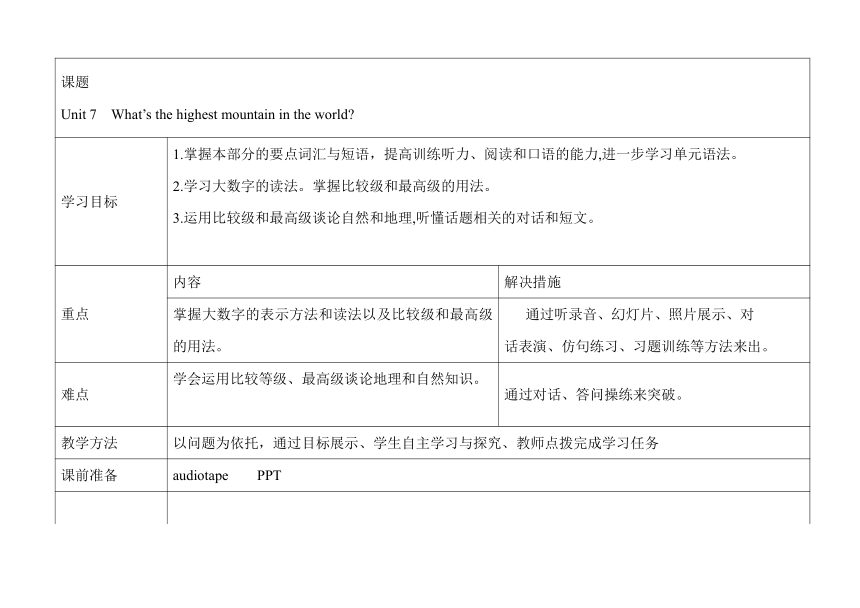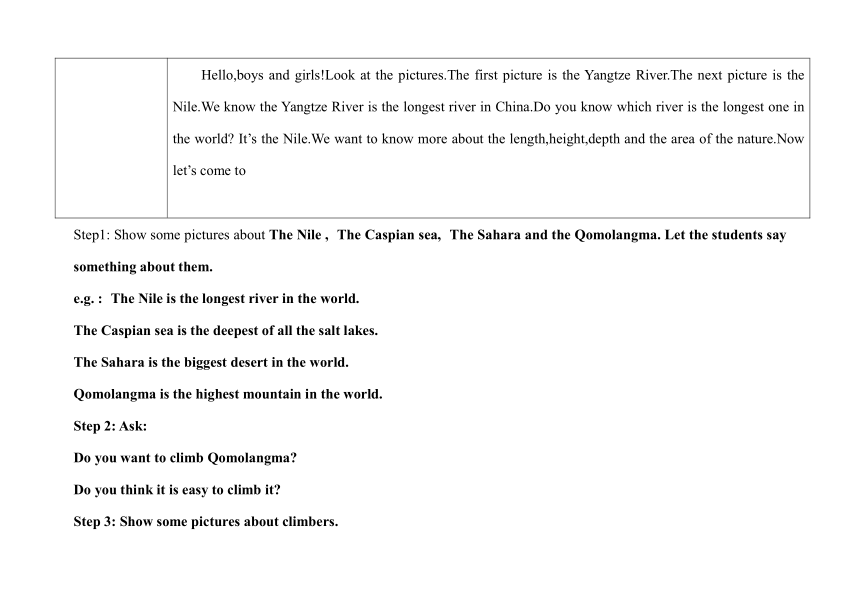人教版八年级下册 Unit7 What's the highest mountain in the world? SectionA 3a-3c 教案(表格式)
文档属性
| 名称 | 人教版八年级下册 Unit7 What's the highest mountain in the world? SectionA 3a-3c 教案(表格式) |

|
|
| 格式 | doc | ||
| 文件大小 | 45.0KB | ||
| 资源类型 | 教案 | ||
| 版本资源 | 人教新目标(Go for it)版 | ||
| 科目 | 英语 | ||
| 更新时间 | 2022-12-23 17:31:14 | ||
图片预览


文档简介
课题Unit 7 What’s the highest mountain in the world
学习目标 1.掌握本部分的要点词汇与短语,提高训练听力、阅读和口语的能力,进一步学习单元语法。2.学习大数字的读法。掌握比较级和最高级的用法。3.运用比较级和最高级谈论自然和地理,听懂话题相关的对话和短文。
重点 内容 解决措施
掌握大数字的表示方法和读法以及比较级和最高级的用法。 通过听录音、幻灯片、照片展示、对话表演、仿句练习、习题训练等方法来出。
难点 学会运用比较等级、最高级谈论地理和自然知识。 通过对话、答问操练来突破。
教学方法 以问题为依托,通过目标展示、学生自主学习与探究、教师点拨完成学习任务
课前准备 audiotape PPT
Hello,boys and girls!Look at the pictures.The first picture is the Yangtze River.The next picture is the Nile.We know the Yangtze River is the longest river in China.Do you know which river is the longest one in the world It’s the Nile.We want to know more about the length,height,depth and the area of the nature.Now let’s come to
Step1: Show some pictures about The Nile , The Caspian sea, The Sahara and the Qomolangma. Let the students say something about them.
e.g. : The Nile is the longest river in the world.
The Caspian sea is the deepest of all the salt lakes.
The Sahara is the biggest desert in the world.
Qomolangma is the highest mountain in the world.
Step 2: Ask:
Do you want to climb Qomolangma
Do you think it is easy to climb it
Step 3: Show some pictures about climbers.
Step 4: Show learning aims:
1.掌握本课重点单词、短语及句型结构。
2.继续学习、巩固形容词和副词的比较级和最高级
3. 通过训练掌握一定的阅读技巧及归纳文章大意的方法。
4.向登山者们直面困难,挑战自我,永不放弃的精神学习。
Step 5: New words .
Step 6: Skimming:
1.How many paragraphs in this passage
2.When did the first Chinese team reach the top of Qomolangma
3.What is the main idea of each paragraph
Paragraph 1 spirit of climbers
Paragraph 2 achievements of climbers
Paragraph 3 facts and dangers
Step 7: Careful reading:
Read Para. 1. List four dangers.
List dangers for climbers
thick clouds
Read Para 2. Match the years with information.
A. 1953 1. The first Chinese team reached the top.
B. 1960 2. Tenzing Norgay and Edmund Hillary were the first to reach the top.
C. 1975 3. Juko Tabei was the first woman to reach the top.
Read para. 3 , answer the questions.
Q1: Why do so many people try to climb this mountain even though it is dangerous
Q2: What does the spirit of the climbers show us
Read para. 1and 3, list four comparisons.
Step 8: Fill in the blanks.
学习目标 1.掌握本部分的要点词汇与短语,提高训练听力、阅读和口语的能力,进一步学习单元语法。2.学习大数字的读法。掌握比较级和最高级的用法。3.运用比较级和最高级谈论自然和地理,听懂话题相关的对话和短文。
重点 内容 解决措施
掌握大数字的表示方法和读法以及比较级和最高级的用法。 通过听录音、幻灯片、照片展示、对话表演、仿句练习、习题训练等方法来出。
难点 学会运用比较等级、最高级谈论地理和自然知识。 通过对话、答问操练来突破。
教学方法 以问题为依托,通过目标展示、学生自主学习与探究、教师点拨完成学习任务
课前准备 audiotape PPT
Hello,boys and girls!Look at the pictures.The first picture is the Yangtze River.The next picture is the Nile.We know the Yangtze River is the longest river in China.Do you know which river is the longest one in the world It’s the Nile.We want to know more about the length,height,depth and the area of the nature.Now let’s come to
Step1: Show some pictures about The Nile , The Caspian sea, The Sahara and the Qomolangma. Let the students say something about them.
e.g. : The Nile is the longest river in the world.
The Caspian sea is the deepest of all the salt lakes.
The Sahara is the biggest desert in the world.
Qomolangma is the highest mountain in the world.
Step 2: Ask:
Do you want to climb Qomolangma
Do you think it is easy to climb it
Step 3: Show some pictures about climbers.
Step 4: Show learning aims:
1.掌握本课重点单词、短语及句型结构。
2.继续学习、巩固形容词和副词的比较级和最高级
3. 通过训练掌握一定的阅读技巧及归纳文章大意的方法。
4.向登山者们直面困难,挑战自我,永不放弃的精神学习。
Step 5: New words .
Step 6: Skimming:
1.How many paragraphs in this passage
2.When did the first Chinese team reach the top of Qomolangma
3.What is the main idea of each paragraph
Paragraph 1 spirit of climbers
Paragraph 2 achievements of climbers
Paragraph 3 facts and dangers
Step 7: Careful reading:
Read Para. 1. List four dangers.
List dangers for climbers
thick clouds
Read Para 2. Match the years with information.
A. 1953 1. The first Chinese team reached the top.
B. 1960 2. Tenzing Norgay and Edmund Hillary were the first to reach the top.
C. 1975 3. Juko Tabei was the first woman to reach the top.
Read para. 3 , answer the questions.
Q1: Why do so many people try to climb this mountain even though it is dangerous
Q2: What does the spirit of the climbers show us
Read para. 1and 3, list four comparisons.
Step 8: Fill in the blanks.
同课章节目录
- Unit 1 What's the matter?
- Section A
- Section B
- Unit 2 I'll help to clean up the city parks.
- Section A
- Section B
- Unit 3 Could you please clean your room?
- Section A
- Section B
- Unit 4 Why don't you talk to your parents?
- Section A
- Section B
- Unit 5 What were you doing when the rainstorm came
- Section A
- Section B
- Review of Units 1-5
- Unit 6 An old man tried to move the mountains.
- Section A
- Section B
- Unit 7 What's the highest mountain in the world?
- Section A
- Section B
- Unit 8 Have you read Treasure Island yet?
- Section A
- Section B
- Unit 9 Have you ever been to a museum?
- Section A
- Section B
- Unit 10 I've had this bike for three years.
- Section A
- Section B
